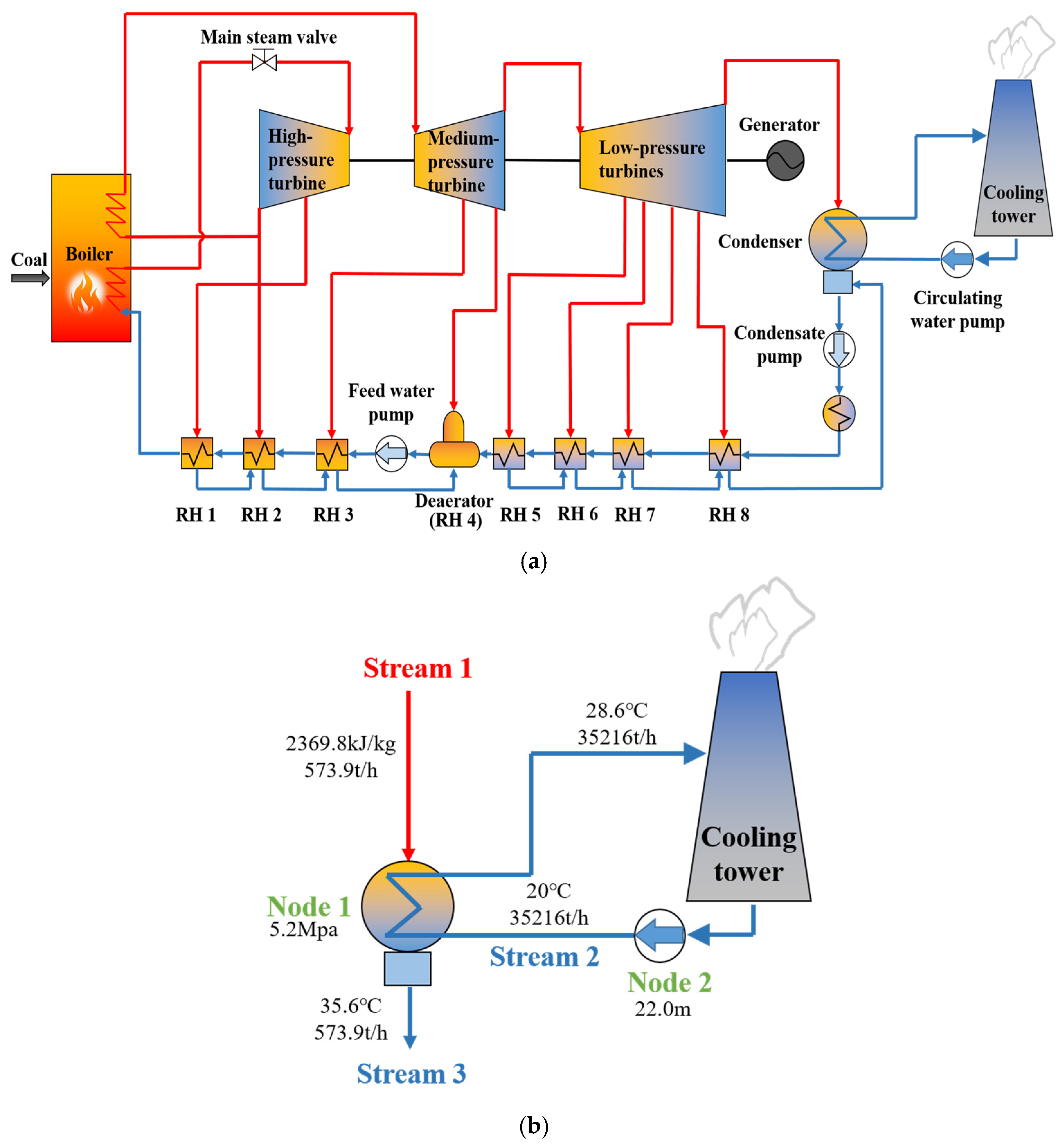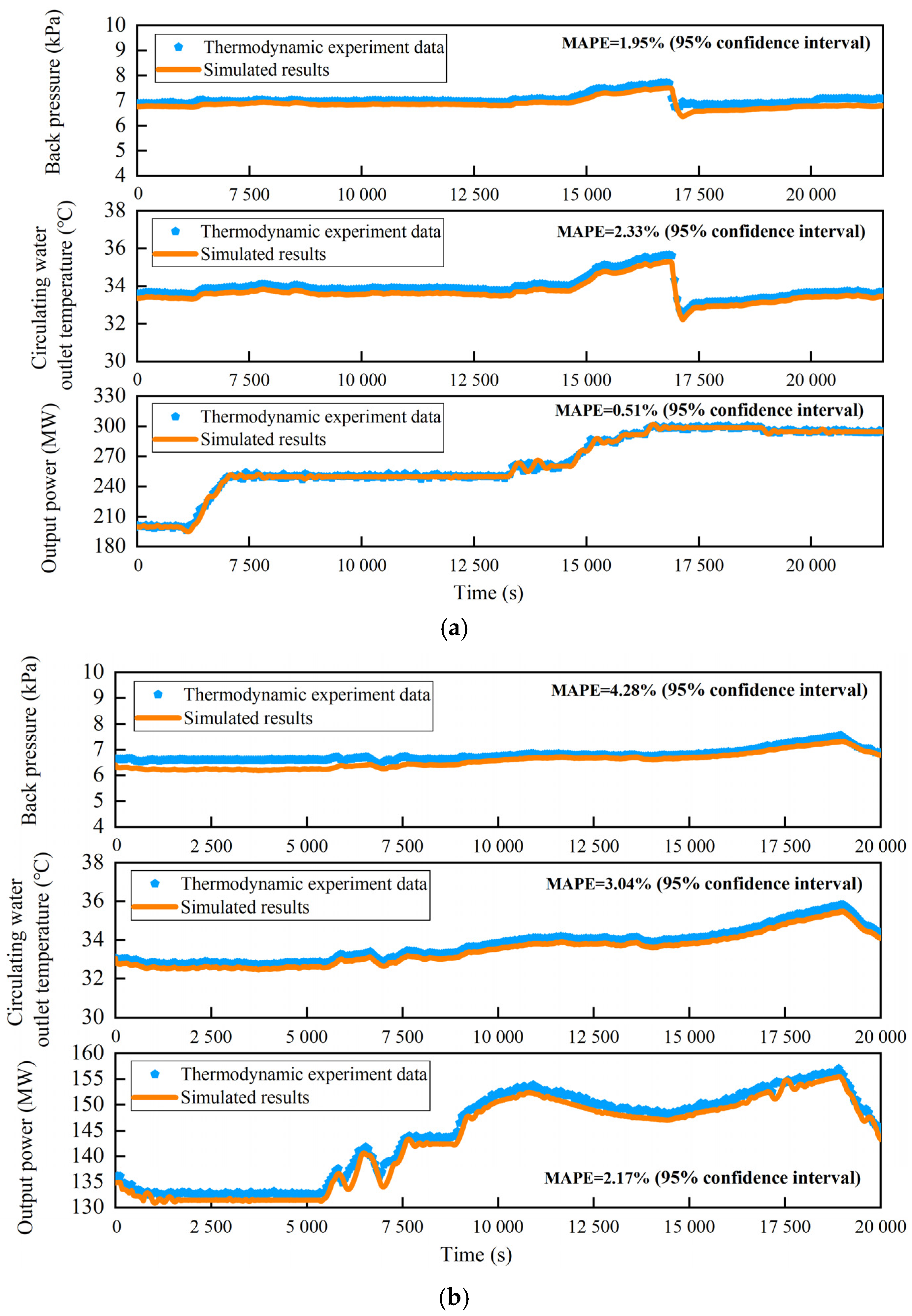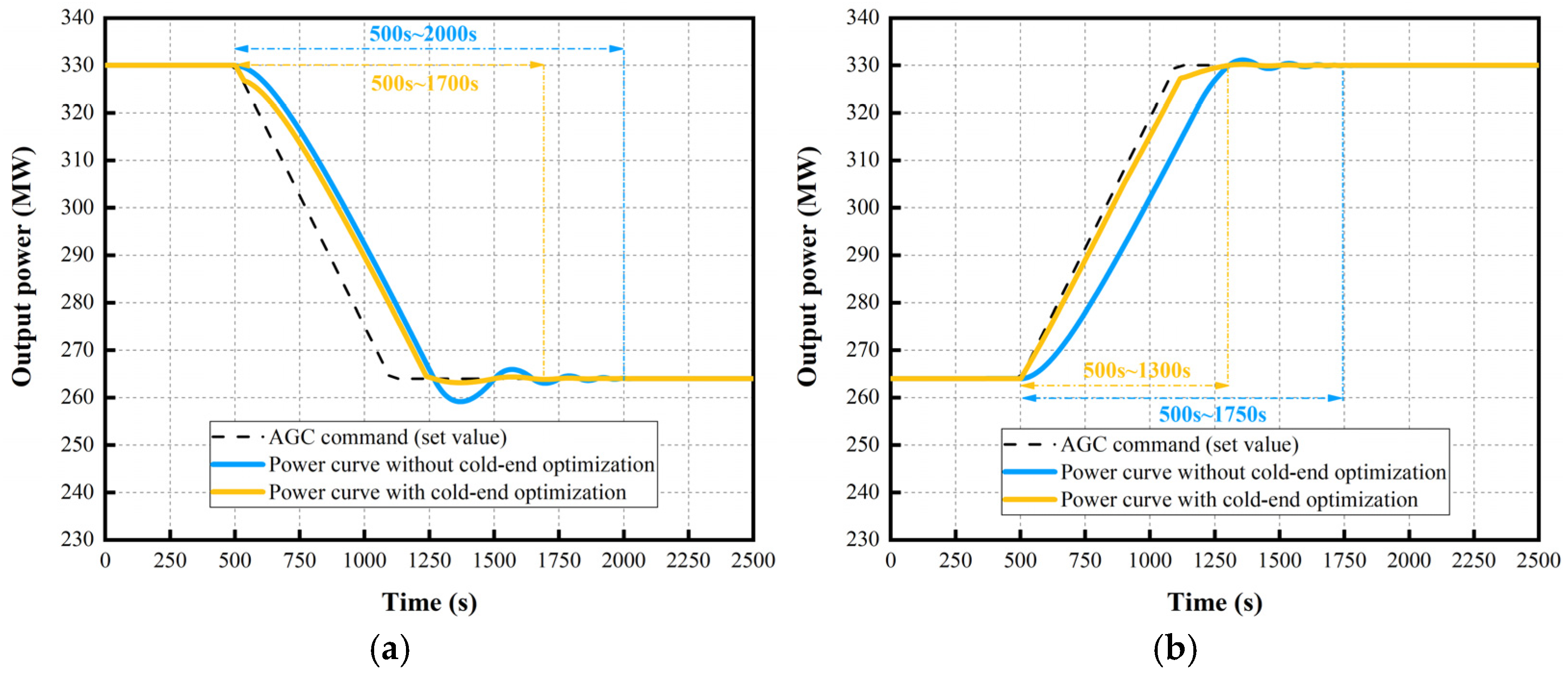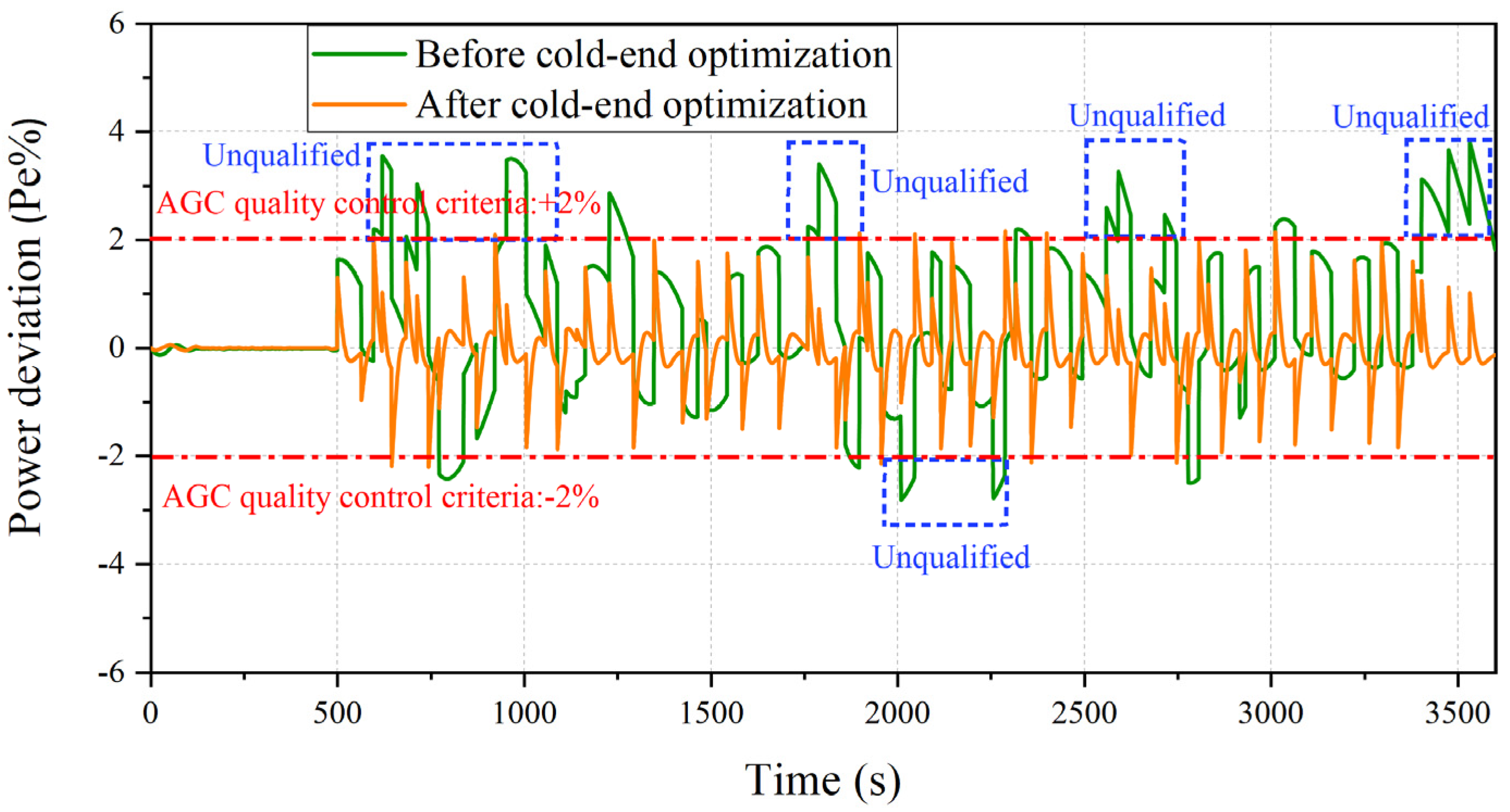Improving the Flexibility of Coal-Fired Power Units by Dynamic Cold-End Optimization
Abstract
1. Introduction
2. Thermodynamic Model
2.1. System Description
2.2. Model Development of the Cold-End System
2.2.1. Model of the Condenser
2.2.2. Model of the Circulating Water Pump
2.2.3. Effect of Back Pressure on Output Power
3. Model Validation
4. Results and Discussion
4.1. Dynamic Characteristics of the End-Cold System
4.2. Application of the Cold-End Optimization in Load-Variation Processes
4.2.1. Control Strategy of the Cold-End Optimization
4.2.2. Performance Improvement in the Load-Variation Processes
4.3. Application of the Cold-End Optimization in Actual AGC Response
4.3.1. Summer Scenario
4.3.2. Winter Scenario
4.4. Comparison of the Cold-End Optimization and Other Flexibility Technologies
5. Conclusions
- (a)
- The dynamic characteristics of the cold-end system under a step change of −50% in the circulating water flow were studied. The results show that the load ratio of the power unit rate does not affect the final stabilized value of the back pressure, but it affects the required time to reach the stabilized value. The lower the power load ratio, the faster the back pressure reaches the stabilized value. In addition, the load ratio of the power unit affects the magnitude of the final power change, and the larger the load ratio is, the greater the impact of the variation of the circulating water flow on the changed power.
- (b)
- The cold-end optimization can be used to improve the unit’s AGC response. When the back pressure of the unit is 7.0 kPa, the cold-end optimization is more effective in improving the unit’s response to the load-decrease commands, in which the comprehensive performance indicator KP increases from 2.96 to 5.03. On the contrary, when the unit operates with a relatively high back pressure (11.8 kPa), the cold-end optimization is more suitable for improving the unit’s response to the load-increase commands, in which the comprehensive performance indicator KP increases from 2.96 to 5.28.
- (c)
- The feasibility of the cold-end optimization in enhancing the unit’s response to actual AGC signals was investigated under two scenarios. The results show that the AGC response quality is noticeably enhanced, which improves the phenomenon of overshooting and reverse regulation. The comprehensive performance indicator KP increased from 2.27 to 4.63 in the summer scenario, while it increased from 2.08 to 4.34 in the winter scenario. Moreover, the profits under the two scenarios were raised by 39.2% and 42.5%, respectively.
- (d)
- The cold-end optimization is compared with other flexibility technologies. The results show that compared with the integration of external flexibility devices, the cold-end optimization has significant advantages in terms of cost and risk, although the effect of improving AGC response is slightly worse than that of batteries and flywheels. Moreover, compared with the unit internal adjustment methods, the operational safety risk is lower, due to the fact that the cold-end optimization technology will not affect the operation of the boiler.
Author Contributions
Funding
Data Availability Statement
Conflicts of Interest
Appendix A


Appendix B
| Items | Value |
|---|---|
| 4.18 kJ/kg | |
| 3396 W/(m2·K) | |
| 2251 W/(m2·K) | |
| 155 t | |
| 18,232 m2 | |
| −7.08 × 10−9 | |
| −3.599 × 10−5 | |
| 32 | |
| 3.63 × 10−9 |
Appendix C
| Parameter | Variation |
|---|---|
| +1.0 kPa | |
| +2.89 t/h | |
| +2.78 t/h | |
| +3.10 t/h | |
| +4.22 t/h | |
| −2.519 MW | |
| −0.251 MW | |
| −2.268 MW |
References
- National Energy Administration. China Electricity Industry Statistics 2023. Available online: https://www.nea.gov.cn/2024-01/26/c_1310762246.htm (accessed on 13 June 2025).
- The State Council Information Office of China. Renewable Energy Accounts for 56 pct of China’s Total Installed Capacity. Available online: https://english.www.gov.cn/archive/statistics/202501/28/content_WS6798de96c6d0868f4e8ef410.html (accessed on 13 June 2025).
- Zhang, Z.; Chen, Y.; Ma, T.; Tian, H.; Liu, J.; Zhou, M.; Wang, W. Multi-type energy storage expansion planning: A review for high-penetration renewable energy integration. Renew. Sustain. Energy Rev. 2025, 219, 115853. [Google Scholar] [CrossRef]
- Wang, C.; Chen, F.; Xu, P.; Cao, H.; Wang, W.; Sun, Q. Dynamic simulation of a subcritical coal-fired power plant with the emphasis on flexibility. Appl. Energy 2025, 392, 125976. [Google Scholar] [CrossRef]
- Liu, M.; Wang, S.; Zhao, Y.; Tang, H.; Yan, J. Heat–power decoupling technologies for coal-fired CHP plants: Operation flexibility and thermodynamic performance. Energy 2019, 188, 116074. [Google Scholar] [CrossRef]
- Wang, C.; Song, J. Performance assessment of the novel coal-fired combined heat and power plant integrating with flexibility renovations. Energy 2023, 263, 125886. [Google Scholar] [CrossRef]
- Li, J.; Li, X.; Yan, P.; Zhou, G.; Liu, J.; Yu, D. Thermodynamics, flexibility and techno-economics assessment of a novel integration of coal-fired combined heating and power generation unit and compressed air energy storage. Appl. Energy 2023, 339, 120924. [Google Scholar] [CrossRef]
- Wang, C.; Song, J.; Zheng, W.; Zhu, L.; Guo, J.; Wang, W. Integration of compressed air energy storage into combined heat and power plants: A solution to flexibility and economy. Energy Convers. Manag. 2023, 290, 117215. [Google Scholar] [CrossRef]
- Zhang, K.; Liu, M.; Zhao, Y.; Yan, H.; Yan, J. Design and performance evaluation of a new thermal energy storage system integrated within a coal-fired power plant. J. Energy Storage 2022, 50, 104335. [Google Scholar] [CrossRef]
- Miao, L.; Liu, M.; Zhang, K.; Zhao, Y.; Yan, J. Energy, exergy, and economic analyses on coal-fired power plants integrated with the power-to-heat thermal energy storage system. Energy 2023, 284, 129236. [Google Scholar] [CrossRef]
- Zhang, K.; Zhao, Y.; Liu, M.; Gao, L.; Fu, Y.; Yan, J. Flexibility enhancement versus thermal efficiency of coal-fired power units during the condensate throttling processes. Energy 2021, 218, 119534. [Google Scholar] [CrossRef]
- Liu, Z.; Wang, C.; Fan, J.; Liu, M.; Xing, Y.; Yan, J. Enhancing the flexibility and stability of coal-fired power plants by optimizing control schemes of throttling high-pressure extraction steam. Energy 2024, 288, 129756. [Google Scholar] [CrossRef]
- Chen, C.; Zhao, C.; Liu, M.; Wang, C.; Yan, J. Enhancing the load cycling rate of subcritical coal-fired power plants: A novel control strategy based on data-driven feedwater active regulation. Energy 2024, 312, 133627. [Google Scholar] [CrossRef]
- Wang, H.; Qiu, B.; Zhao, F.; Yan, T. Method for increasing net power of power plant based on operation optimization of circulating cooling water system. Energy 2023, 282, 128392. [Google Scholar] [CrossRef]
- Naderi, E.; Azizivahed, A.; Asrari, A. A step toward cleaner energy production: A water saving-based optimization approach for economic dispatch in modern power systems. Electr. Power Syst. Res. 2022, 204, 107689. [Google Scholar] [CrossRef]
- Wang, P.; Wang, Y.; Wang, B. Optimization operation of steam turbine cold end and best back pressure research and application. Turbine Technol. 2016, 58, 55–57+60. (In Chinese) [Google Scholar]
- Wang, W.; Zeng, D.; Liu, J.; Niu, Y.; Cui, C. Feasibility analysis of changing turbine load in power plants using continuous condenser pressure adjustment. Energy 2014, 64, 533–540. [Google Scholar] [CrossRef]
- Wang, W.; Zeng, D.; Liu, J.; Niu, Y.; Cui, C. An improved coordinated control strategy for boiler-turbine units supplemented by cold source flow adjustment. Energy 2015, 88, 927–934. [Google Scholar] [CrossRef]
- Li, Y.; Zhao, L.; Zhang, X.; Wei, H.; Du, X. Energy consumption during transient operation of coal-fired generating units with cold end system back pressure regulation. Appl. Therm. Eng. 2024, 248, 123188. [Google Scholar] [CrossRef]
- Han, Z.; Xiang, P. Modeling condensate throttling to improve the load change performance of cogeneration units. Energy 2020, 192, 116684. [Google Scholar] [CrossRef]
- Dhir, V.; Lienhard, J. Laminar Film Condensation on Plane and Axisymmetric Bodies in Nonuniform Gravity. ASME J. Heat Mass Transf. 1971, 93, 97–100. [Google Scholar] [CrossRef]
- Yao, L.; Xiao, X.; Wang, Y.; Yao, X.; Ma, Z. Dynamic modeling and hierarchical control of a concentrated solar power plant with direct molten salt storage. Energy 2022, 252, 123999. [Google Scholar] [CrossRef]
- Wang, W.; Liu, J.; Zeng, D.; Li, Z.; Cui, C. Variable-speed technology used in power plants for better plant economics and grid stability. Energy 2012, 45, 588–594. [Google Scholar] [CrossRef]
- Wang, C.; Song, J.; Zheng, W.; Liu, Z.; Lin, C. Analysis of economy, energy efficiency, environment: A case study of the CHP system with both civil and industrial heat users. Case Stud. Therm. Eng. 2022, 30, 101768. [Google Scholar] [CrossRef]
- Wang, R.; Du, X.; Shi, Y.; Deng, W.; Wang, Y.; Sun, F. A novel system for reducing power plant electricity consumption and enhancing deep peak-load capability. Energy 2024, 295, 131031. [Google Scholar] [CrossRef]
- Afram, A.; Janabi-Sharifi, F. Gray-box modeling and validation of residential HVAC system for control system design. Appl. Energy 2015, 137, 134–150. [Google Scholar] [CrossRef]
- Yin, J.; Liu, M.; Zhao, Y.; Wang, C.; Yan, J. Dynamic performance and control strategy modification for coal-fired power unit under coal quality variation. Energy 2021, 223, 120077. [Google Scholar] [CrossRef]
- DLT 657-2015; Code for Acceptance Test of Modulating Control System in Fossil Fuel Power Plant. China Electricity Council: Beijing, China, 2015. Available online: https://std.samr.gov.cn/hb/search/stdHBDetailed?id=8B1827F21C35BB19E05397BE0A0AB44A (accessed on 23 June 2025).
- Shandong Energy Regulatory Office of National Energy Administration of the People’s Republic of China. Implementing Rules for the Management of Electricity Auxiliary Services in Shandong Province. Available online: https://sdb.nea.gov.cn/dtyw/tzgg/202309/t20230919_110474.html (accessed on 23 June 2025).
- Wang, S.; Yan, H.; Li, J.; Zhang, Y.; Ma, H.; Han, Z.; Xu, C. Power distribution strategy of energy storage system auxiliary secondary frequency regulation considering battery life. Clean Coal Technol. 2024, 30, 95–101. (In Chinese) [Google Scholar]
- Yang, T.; Liu, Z.; Zeng, D.; Zhu, Y. Simulation and evaluation of flexible enhancement of thermal power unit coupled with flywheel energy storage array. Energy 2023, 281, 128239. [Google Scholar] [CrossRef]
- Wang, C.; Liu, F. Dynamic performance of a power plant integrating with molten salt thermal energy storage. Appl. Therm. Eng. 2025, 262, 125223. [Google Scholar] [CrossRef]













| Items | Value | |
|---|---|---|
| Node 1 | Choked back pressure/kPa | 5.2 |
| Node 2 | Circulating water pump efficiency/% | 86.7 |
| Circulating water pump head/m | 22.0 | |
| Stream 1 | Condenser circulating water inlet/outlet temperature/°C | 20.0/28.6 |
| Circulating water flow rate/t·h−1 | 35,216 | |
| Circulating water Pressure/Mpa | 0.22 | |
| Stream 2 | Exhaust steam enthalpy/kJ·kg−1 | 2369.8 |
| Exhaust steam flow rate/t·h−1 | 573.9 | |
| Stream 3 | Condensation water temperature/°C | 35.6 |
| Items | Value |
|---|---|
| Maximum coal feed rate/t·h−1 | 104.7 |
| Maximum change rate of coal feed rate/t·h−1·min−1 | 2.094 |
| Maximum circulating water flow rate/t·h−1 | 48,112 |
| Boiler PID parameters | kp = 300; ki = 0.05; kd = 20 |
| Cold-end PID parameters | kp = 10; ki = 0.2; kd = 15 |
| Items | Load-Decrease Process Before Optimization | Load-Decrease Process After Optimization | Load-Increase Process Before Optimization | Load-Increase Process After Optimization |
|---|---|---|---|---|
| IAE/MWh | 2.91 | 0.44 | 2.63 | 2.18 |
| K1 | 1.03 | 1.38 | 1.08 | 1.16 |
| K2 | 1.72 | 1.99 | 1.98 | 1.99 |
| K3 | 1.67 | 1.83 | 1.71 | 1.85 |
| KP | 2.96 | 5.03 | 3.66 | 4.27 |
| Items | Load-Decrease Process Before Optimization | Load-Decrease Process After Optimization | Load-Increase Process Before Optimization | Load-Increase Process After Optimization |
|---|---|---|---|---|
| IAE/MWh | 2.91 | 2.41 | 2.63 | 0.39 |
| K1 | 1.03 | 1.10 | 1.08 | 1.42 |
| K2 | 1.72 | 1.98 | 1.98 | 1.99 |
| K3 | 1.67 | 1.73 | 1.71 | 1.87 |
| KP | 2.96 | 3.77 | 3.66 | 5.28 |
| Flexibility Technologies | The Enhancement Effect on AGC Response | Cost | Safety Risks | |
|---|---|---|---|---|
| Integration of external devices | Lithium battery [30] | Kp was improved up to 6 | High | Medium |
| Flywheel [31] | Kp was improved up to 7.5 | High | Low | |
| Molten salt thermal energy storage [32] | Ramp rate was improved up to 5.94% PN/min | Medium | Medium | |
| Unit internal adjustment methods | Condensate throttling [20] | Ramp rate was improved up to 6.57% PN/min | Almost zero | Medium |
| high-pressure extraction steam throttling [12] | Kp was improved by 2.11 | Almost zero | High | |
| feedwater active regulation [13] | Kp was improved up to 3.65 | Almost zero | High | |
| Cold-end optimization (this study) | Kp was improved up to more than 4 | Almost zero | Low | |
Disclaimer/Publisher’s Note: The statements, opinions and data contained in all publications are solely those of the individual author(s) and contributor(s) and not of MDPI and/or the editor(s). MDPI and/or the editor(s) disclaim responsibility for any injury to people or property resulting from any ideas, methods, instructions or products referred to in the content. |
© 2025 by the authors. Licensee MDPI, Basel, Switzerland. This article is an open access article distributed under the terms and conditions of the Creative Commons Attribution (CC BY) license (https://creativecommons.org/licenses/by/4.0/).
Share and Cite
Zhang, Y.; Fang, X.; Kong, Z.; Yang, Z.; Lao, J.; Zheng, W.; Zhu, L.; Song, J. Improving the Flexibility of Coal-Fired Power Units by Dynamic Cold-End Optimization. Energies 2025, 18, 3375. https://doi.org/10.3390/en18133375
Zhang Y, Fang X, Kong Z, Yang Z, Lao J, Zheng W, Zhu L, Song J. Improving the Flexibility of Coal-Fired Power Units by Dynamic Cold-End Optimization. Energies. 2025; 18(13):3375. https://doi.org/10.3390/en18133375
Chicago/Turabian StyleZhang, Yanpeng, Xinzhen Fang, Zihan Kong, Zijiang Yang, Jinxu Lao, Wei Zheng, Lingkai Zhu, and Jiwei Song. 2025. "Improving the Flexibility of Coal-Fired Power Units by Dynamic Cold-End Optimization" Energies 18, no. 13: 3375. https://doi.org/10.3390/en18133375
APA StyleZhang, Y., Fang, X., Kong, Z., Yang, Z., Lao, J., Zheng, W., Zhu, L., & Song, J. (2025). Improving the Flexibility of Coal-Fired Power Units by Dynamic Cold-End Optimization. Energies, 18(13), 3375. https://doi.org/10.3390/en18133375




